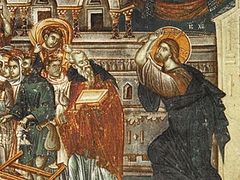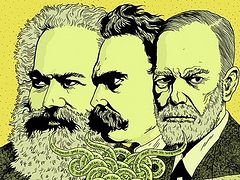Feodor Dostoevsky expressed the following idea in one of his diaries: “Socialism, communism and atheism are the three easiest disciplines. Having driven them into his head, a young lad considers himself a wise man. Additionally, these disciplines lend themselves more easily to popular explanation than any others.”
We’ll now discuss one such popular explanation: a book that can easily be found on the “bestsellers” shelf of most bookstores.
The book in question is the novel “Origin”, written by the American author Dan Brown. It’s about the usual adventures of the professor and cryptologist Robert Langdon, and is part of a series that has now exceeded a total of 200 million published copies and has been translated into over 56 languages. It could be worth noting that in “The Da Vinci Code”, the book that brought the author his fame, only the last few chapters were dedicated to a cautious attack on Christianity (in the form of a free paraphrase of almost forgotten and long-refuted heresies1 about the human nature of Christ), whereas the “Origin” is fully dedicated to this topic, to an attack on all religions in the world at once. That’s what often happens—a false idea not initially rejected by the mass consciousness begins to grow over time. As Joseph Goebbels would say, “A lie told a thousand times becomes the truth”.
By the way, in 2018, according to the rating of the most popular books on the shelves of the “book-crossing” (a book exchange program) in the Moscow metro, The Da Vinci Code is ranked near the top. How many more millions of people will read these books, and how many more people are they capable of confusing? How many people will undiscerningly absorb this seemingly harmless deception?
It’s difficult to raise reasonable objections to the author when in his previous books he writes in all seriousness, for example, that Christians borrowed the practice of receiving Holy Communion from the Aztecs. A child in school would rightly get an “F” in history for such a statement. The distance between the Aztecs and the first Communion described in the New Testament marks a span of 1500 years, and a many-thousand kilometer distance between two different continents. These two cultures did not come into contact before the discovery of America in 1492. However, Dan Brown and his publishers somehow succeed in selling millions of copies with “discoveries” such as these. That’s talent—marketing talent.
On the first page of the “Origin” we read the following in the preface: “Fact: All art, architecture, locations, science, and religious organizations in this novel are real”.
This is obviously supposed to convey a sense of credibility to the reader. So, let’s try to figure out what actually exists in reality, and what exists only in the author’s own imagination.
The main idea, the core of the entire novel, is a clash between science and religion. Almost on every page in different ways the following idea is stated: everything that is “scientific” contradicts “religion”, and everything “religious” can in no way be “scientific”. These statements are strange, at the very least because they are unscientific. The existence of even one religious scientist (and in fact they make up more than half the total number of scientists2) already denounces this false hypothesis. But let’s return to the book.
The plot: Edmond Kirsch, a fictional character, a zealous atheist and part-time futurologist makes some kind of scientific discovery. The scientist hurries to share this discovery with the whole world, making a presentation at the museum of modern art, during which he is killed. As you can easily guess, Professor Robert Langdon must uncover all the secrets, ciphers and codes, and nonetheless reveal the discovery to the world. Let’s note that the book has less than 600 pages, 500 of which describe this discovery in hints:
-
It will reveal the greatest mystery of humanity;
-
it is “groundbreaking” and “ingenious”;
-
it will open a new era in the history of mankind;
-
it will disprove all world religions;
There is something endlessly naïve in this. According to the American analytical Pew Research Center, around 5.8 billion people out of the 7 billion of the Earth’s total population consider themselves religious3, i.e. followers of a particular religion. But, once this presentation is shown to these 6 billion people around the world, everything they believe in will instantly be “refuted”…
The ingenious discovery of Edmond Kirsch turns out to be… a retelling of the theory of evolution. The essence of Darwin’s teaching is actually very simple—it’s based on a hypothesis, which has never been proven by anyone, about the spontaneous origin of life in some kind of “primordial soup”. Something living somehow appeared from something dead. Let’s note that, academically speaking, the hypothesis itself can be qualified as science, one of the signs of which is the presence of a scientific hypothesis (assumption). But when we start going further, things become more difficult.
The fundamental criterion of a hypothesis is that it must be verifiable; there must be a way to verify it by critical experiment. If someone states that what is living came into being on its own from something dead—well, that’s a strange assumption, but they have the right to propose so. All that’s left to do is to prove (or disprove) this hypothesis with an experiment. Scientists now have the most modern laboratories at their disposal, along every possible combination of elements and organic and inorganic chemicals, the possibility to reproduce any environmental conditions (heat, cold, electrical charges that mimic the thunder and lightning of the “primordial soup” theory). When someone succeeds in getting at least one live cell out of dead matter, then we’ll talk. The success that the supporters of Darwin’s theory have had with this within the last 150 years is quite modest—it’s simply nonexistent. Nothing living seems to want to come out from something dead.
Now it’s necessary to clarify something: A full-fledged universal quantum computer is still a hypothetical device. Practically only a handful of experimental systems are implemented today and are used to execute fixated, noncomplex algorithms.
It is around the experiment described above (i.e. attempts at imitating the spontaneous generation of life on a planet) that Dan Brown builds his plot. The author acts straightforwardly and boldly; if the hypothesis is not supported by the facts, then so much worse for the facts. During the course of the plot it turns out that Edmond Kirsch (who—just a reminder—is a fictional character), using a quantum supercomputer that he invented himself (but which does not exist in reality), launches some kind of mathematical model. Then, on the basis of a technique used in the production of cartoons (“tweening”, as it’s called—a process in which transitional frames are generated between two key frames), Kirsch proves that life on Earth originated on its own.
And that’s it.
And no less of an illustration can be given by the many other ideas that were seemingly coincidentally dropped here and there throughout the entire book. This is one of the main signs of consciousness manipulation: when unproven statements are dropped in casually, lightly, as something that’s supposedly well known. For example, during Edmond Kirsch’s presentation the following is said about the alleged main problems that stand in the way of science’s free development:
“…Religious billboards condemning stem-cell research, gay rights, and abortion…”
The idea is not explained—you just have to believe it’s true that whoever is against gay rights and abortions is also against science. Further on in the text, throughout the entire novel, there is an “informational bombardment” against the following concepts: monarchy (of any kind), religion (any), and traditional family values; whilst abortions and same-sex marriage are presented as good things.
For example, there is a quite transparent allusion to the homosexual relationship between an elderly king of Spain and a Catholic bishop, which is portrayed as “love” to which “everyone has the right”. Or there’s this amazing “creed” held by one of the positively presented characters—a progressive Catholic priest:
“We should all do what so many churches already do—openly admit that Adam and Eve did not exist, that evolution is a fact, and that Christians who declare otherwise make us all look foolish.”
So, as they say, what’s the bottom line? A fictional character, with the help of a non-existent quantum computer, using cartoon technology, draws a conclusion not proven by experiments about the spontaneous generation of life on planet Earth. And that’s it? Yes, that’s it.
Great marketing. And an absolutely useless “groundbreaking discovery”.





We embrace our emotional weakness by embracing man's Reason, and attack those who draw our attention to that weakness.